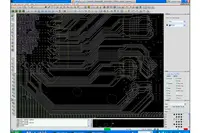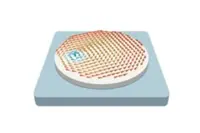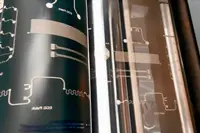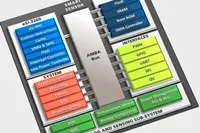Electronics News
Archive : 7 December 2015 год
 Cadence Design Systems and Spreadtrum have developed a virtual reference design kit specific to Spreadtrum’s SC9830A quad-core system-on-chip (SoC) platform requirements. The kit is claimed to enable designers to accelerate their product and application design cycles by up to 12 weeks, including time spent on schematic design, PCB design and power-aware signal integrity (SI) and power integrity (PI) signoff simulation.
Cadence Design Systems and Spreadtrum have developed a virtual reference design kit specific to Spreadtrum’s SC9830A quad-core system-on-chip (SoC) platform requirements. The kit is claimed to enable designers to accelerate their product and application design cycles by up to 12 weeks, including time spent on schematic design, PCB design and power-aware signal integrity (SI) and power integrity (PI) signoff simulation.
This virtual reference design kit is intended to guide engineers as they design the Spreadtrum SC9830A quad-core SoC into a target PCB design. Using the virtual reference design kit, users can take the SC9830A reference PCB design and re-use portions relevant for their target design and adapt other portions as required.
The virtual reference design kit includes data examples and analysis models pre-populated for use in: Cadence Allegro PCB Designer; Cadence Sigrity PowerDC technology; Cadence Sigrity Power SI technology; and Cadence Sigrity power-aware SI flow for LPDDRn
John Rowland, svp of hardware engineering at Spreadtrum, said: “Our customers can now begin to optimise the cost and performance of their products to take advantage of all the Spreadtrum SC9830A features, while meeting accelerated time-to-market challenges.”
Author
Tom Austin-Morgan
Source: www.newelectronics.co.uk
 Researchers at Linköping University’s Laboratory of Organic Electronics have developed ‘power paper’. The material consists of nanocellulose and a conductive polymer and has the ability to store energy.
Researchers at Linköping University’s Laboratory of Organic Electronics have developed ‘power paper’. The material consists of nanocellulose and a conductive polymer and has the ability to store energy.
The researchers claim that one sheet, 15cm in diameter and a few tenths of a millimetre thick can store as much as 1farad, which is similar to the supercapacitors currently on the market. They also say that the material can be recharged in seconds, hundreds of times.
Xavier Crispin, professor of organic electronics at Linköping University, said: “Thin films that function as capacitors have existed for some time. What we have done is to produce the material in three dimensions. We can produce thick sheets.”
Unlike the batteries and condensers currently on the market, power paper is produced from simple materials, is light in weight, requires no dangerous chemicals or heavy metals and it is waterproof.
To form the power paper, cellulose fibres are broken down into fibres as thin as 20nm in diameter, using high-pressure water. Then an electrically charged polymer, also in a water solution, is added that then forms a thin coating around the fibres.
Jesper Edberg, the doctoral student who conducted the experiments, explained: “The covered fibres are in tangles, where the liquid in the spaces between them functions as an electrolyte,”
The cellulose-polymer material has set four world records Highest charge and capacitance in organic electronics, 1Coulomb and 2F; Highest measured current in an organic conductor, 1A; Highest capacity to simultaneously conduct ions and electrons; and Highest transconductance in a transistor.
The next challenge is to develop an industrial-scale process for producing the power paper, which has to be dehydrated like regular paper pulp.
Author
Tom Austin-Morgan
Source: www.newelectronics.co.uk
 A team of scientists, from the Moscow Institute of Physics and Technology (MIPT) and the Russian Quantum Centre, claim to have demonstrated a method of exciting magnetic vortices using less current.
A team of scientists, from the Moscow Institute of Physics and Technology (MIPT) and the Russian Quantum Centre, claim to have demonstrated a method of exciting magnetic vortices using less current.
Controlling magnetic vortices, through spin or otherwise, is what scientists are researching as a foundation for the electronics of the future, called spintronics. In spintronics, information can be transmitted by spin rather than electronic charge, the charged particles do not necessarily need to move anywhere as information will be transmitting ‘along the chain’ via the spin.
Using spin to transmit a unit of information requires less time and energy than a similar operation in modern electronics.
The scientists examined the process of an alternating radio frequency current, of approximately 1GHz, passing along the surface between a ferromagnet and topological insulator.
The study found that in order to excite magnetic vortices with a topological insulator, AC must be used, as DC has almost no effect on them. When AC was applied, a sharp resonance excitation of the vortices was observed. The scientists also noted that the current densities required to excite the vortices were several times lower than previously observed.
Previous experimental studies have shown that current passing along the surface between different layers of a heterostructure such as this is able to generate a torque. The authors of the paper have demonstrated that it is possible to effectively excite magnetic vortices using this torque.
Research into spintronics is essential for the development of modern technologies as Moore’s Law is pushing the technology to its limits. The Russian scientists say it is possible that in the future all technologies will switch from using electrical charges to particle spins, which require minimal amounts of energy and will increase speed thousands of times.
Author
Tom Austin-Morgan
Source: www.newelectronics.co.uk
 Engineers at Oregon State University claim to have made a breakthrough in understanding the physics of photonic ‘sintering’, which could lead to advances in solar cells, flexible electronics, sensors and other high-tech products printed onto something as simple as a sheet of paper or plastic.
Engineers at Oregon State University claim to have made a breakthrough in understanding the physics of photonic ‘sintering’, which could lead to advances in solar cells, flexible electronics, sensors and other high-tech products printed onto something as simple as a sheet of paper or plastic.
Sintering is the fusing of nanoparticles to form a solid, functional thin-film that can be used for many purposes, and the process could have considerable value for new technologies. Photonic sintering has the possible advantage of higher speed and lower cost, compared to other technologies for nanoparticle sintering.
The OSU experts discovered that previous approaches to understand and control photonic sintering had been based on a flawed view of the basic physics involved, which had led to a gross overestimation of product quality and process efficiency.
Based on the new perspective of this process the researchers now believe they can create high quality products at much lower temperatures, at least twice as fast and with 10 times more energy efficiency.
"Lower temperature is a real key," Rajiv Malhotra, an assistant professor of mechanical engineering in the OSU College of Engineering, said. "To lower costs, we want to print these nanotech products on things like paper and plastic, which would burn or melt at higher temperatures. We now know that is possible, and how to do it. We should be able to create production processes that are both fast and cheap, without a loss of quality."
Products that could evolve from the research include solar cells, gas sensors, radiofrequency identification tags, and a range of flexible electronics. Wearable biomedical sensors could emerge, along with new sensing devices for environmental applications.
The researchers say that it should be possible to scale up the process to large manufacturing levels for industrial use.
Author
Tom Austin-Morgan
Source: www.newelectronics.co.uk
 In a move which gives its customers access to one of the most popular real time operating systems, EnSilica has ported Express Logic’s ThreadX RTOS to its eSi-RISC family of embedded processor cores.
In a move which gives its customers access to one of the most popular real time operating systems, EnSilica has ported Express Logic’s ThreadX RTOS to its eSi-RISC family of embedded processor cores.
“While some eSi-RISC customers often choose an open-source RTOS, others believe that a commercially supported RTOS is more preferable for successful embedded product development and fast time-to-market,” said Ian Lankshear, EnSilica’s CEO. “The combination of ThreadX and eSi-RISC delivers unrivalled compactness, high performance and low-power for all manner of embedded applications.”
EnSilica’s eSi-RISC family includes 16bit and 32bit processors, along with optional single precision floating point processors, SIMD DSP extensions and a scalable asymmetric multicore processor.
Bill Lamie, president of Express Logic, noted: “We believe EnSilica’s flexible eSi-RISC processor cores and our highly efficient ThreadX RTOS creates a commercial-grade solution capable of addressing the most demanding projects now and into the future.”
The companies say that, together, eSi-RISC and ThreadX share small footprint, high performance and low power characteristics that, when combined with ThreadX’s precertification for many safety standards, suit them to IoT and industrial applications.
Author
Graham Pitcher
Source: www.newelectronics.co.uk

